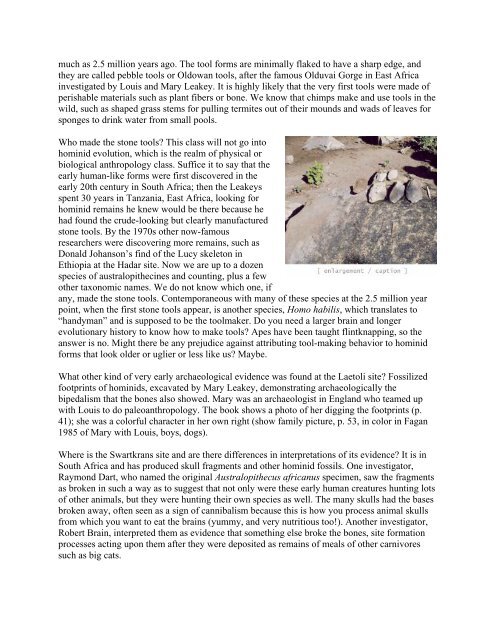INTRODUCTION TO ARCHAEOLOGY Nancy White - Touro Institute
INTRODUCTION TO ARCHAEOLOGY Nancy White - Touro Institute
INTRODUCTION TO ARCHAEOLOGY Nancy White - Touro Institute
Create successful ePaper yourself
Turn your PDF publications into a flip-book with our unique Google optimized e-Paper software.
much as 2.5 million years ago. The tool forms are minimally flaked to have a sharp edge, and<br />
they are called pebble tools or Oldowan tools, after the famous Olduvai Gorge in East Africa<br />
investigated by Louis and Mary Leakey. It is highly likely that the very first tools were made of<br />
perishable materials such as plant fibers or bone. We know that chimps make and use tools in the<br />
wild, such as shaped grass stems for pulling termites out of their mounds and wads of leaves for<br />
sponges to drink water from small pools.<br />
Who made the stone tools? This class will not go into<br />
hominid evolution, which is the realm of physical or<br />
biological anthropology class. Suffice it to say that the<br />
early human-like forms were first discovered in the<br />
early 20th century in South Africa; then the Leakeys<br />
spent 30 years in Tanzania, East Africa, looking for<br />
hominid remains he knew would be there because he<br />
had found the crude-looking but clearly manufactured<br />
stone tools. By the 1970s other now-famous<br />
researchers were discovering more remains, such as<br />
Donald Johanson’s find of the Lucy skeleton in<br />
Ethiopia at the Hadar site. Now we are up to a dozen<br />
species of australopithecines and counting, plus a few<br />
other taxonomic names. We do not know which one, if<br />
any, made the stone tools. Contemporaneous with many of these species at the 2.5 million year<br />
point, when the first stone tools appear, is another species, Homo habilis, which translates to<br />
“handyman” and is supposed to be the toolmaker. Do you need a larger brain and longer<br />
evolutionary history to know how to make tools? Apes have been taught flintknapping, so the<br />
answer is no. Might there be any prejudice against attributing tool-making behavior to hominid<br />
forms that look older or uglier or less like us? Maybe.<br />
What other kind of very early archaeological evidence was found at the Laetoli site? Fossilized<br />
footprints of hominids, excavated by Mary Leakey, demonstrating archaeologically the<br />
bipedalism that the bones also showed. Mary was an archaeologist in England who teamed up<br />
with Louis to do paleoanthropology. The book shows a photo of her digging the footprints (p.<br />
41); she was a colorful character in her own right (show family picture, p. 53, in color in Fagan<br />
1985 of Mary with Louis, boys, dogs).<br />
Where is the Swartkrans site and are there differences in interpretations of its evidence? It is in<br />
South Africa and has produced skull fragments and other hominid fossils. One investigator,<br />
Raymond Dart, who named the original Australopithecus africanus specimen, saw the fragments<br />
as broken in such a way as to suggest that not only were these early human creatures hunting lots<br />
of other animals, but they were hunting their own species as well. The many skulls had the bases<br />
broken away, often seen as a sign of cannibalism because this is how you process animal skulls<br />
from which you want to eat the brains (yummy, and very nutritious too!). Another investigator,<br />
Robert Brain, interpreted them as evidence that something else broke the bones, site formation<br />
processes acting upon them after they were deposited as remains of meals of other carnivores<br />
such as big cats.
















